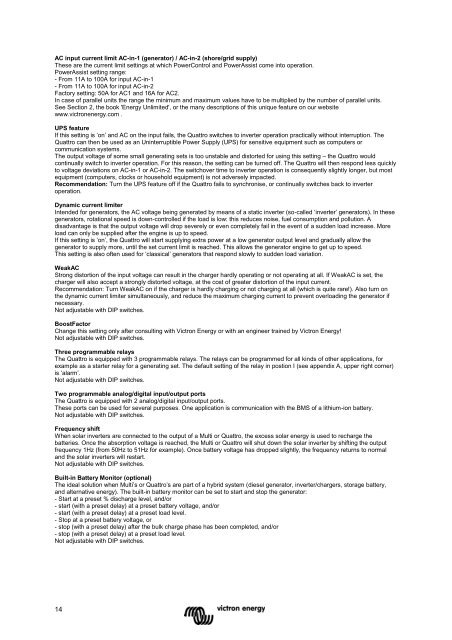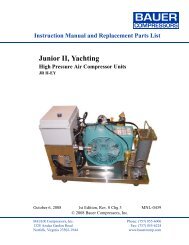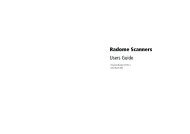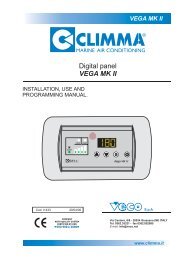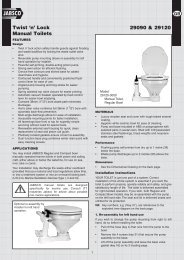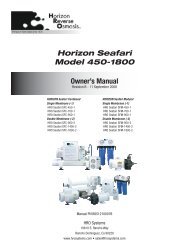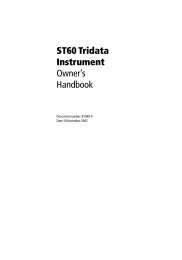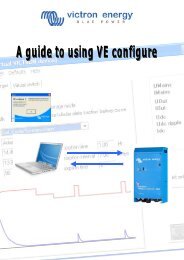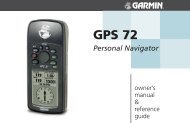Manual Handleiding Manuel Anleitung Manual Manual - Zanshin
Manual Handleiding Manuel Anleitung Manual Manual - Zanshin
Manual Handleiding Manuel Anleitung Manual Manual - Zanshin
Create successful ePaper yourself
Turn your PDF publications into a flip-book with our unique Google optimized e-Paper software.
AC input current limit AC-in-1 (generator) / AC-in-2 (shore/grid supply)<br />
These are the current limit settings at which PowerControl and PowerAssist come into operation.<br />
PowerAssist setting range:<br />
- From 11A to 100A for input AC-in-1<br />
- From 11A to 100A for input AC-in-2<br />
Factory setting: 50A for AC1 and 16A for AC2.<br />
In case of parallel units the range the minimum and maximum values have to be multiplied by the number of parallel units.<br />
See Section 2, the book 'Energy Unlimited', or the many descriptions of this unique feature on our website<br />
www.victronenergy.com .<br />
UPS feature<br />
If this setting is „on‟ and AC on the input fails, the Quattro switches to inverter operation practically without interruption. The<br />
Quattro can then be used as an Uninterruptible Power Supply (UPS) for sensitive equipment such as computers or<br />
communication systems.<br />
The output voltage of some small generating sets is too unstable and distorted for using this setting – the Quattro would<br />
continually switch to inverter operation. For this reason, the setting can be turned off. The Quattro will then respond less quickly<br />
to voltage deviations on AC-in-1 or AC-in-2. The switchover time to inverter operation is consequently slightly longer, but most<br />
equipment (computers, clocks or household equipment) is not adversely impacted.<br />
Recommendation: Turn the UPS feature off if the Quattro fails to synchronise, or continually switches back to inverter<br />
operation.<br />
Dynamic current limiter<br />
Intended for generators, the AC voltage being generated by means of a static inverter (so-called „inverter‟ generators). In these<br />
generators, rotational speed is down-controlled if the load is low: this reduces noise, fuel consumption and pollution. A<br />
disadvantage is that the output voltage will drop severely or even completely fail in the event of a sudden load increase. More<br />
load can only be supplied after the engine is up to speed.<br />
If this setting is „on‟, the Quattro will start supplying extra power at a low generator output level and gradually allow the<br />
generator to supply more, until the set current limit is reached. This allows the generator engine to get up to speed.<br />
This setting is also often used for „classical‟ generators that respond slowly to sudden load variation.<br />
WeakAC<br />
Strong distortion of the input voltage can result in the charger hardly operating or not operating at all. If WeakAC is set, the<br />
charger will also accept a strongly distorted voltage, at the cost of greater distortion of the input current.<br />
Recommendation: Turn WeakAC on if the charger is hardly charging or not charging at all (which is quite rare!). Also turn on<br />
the dynamic current limiter simultaneously, and reduce the maximum charging current to prevent overloading the generator if<br />
necessary.<br />
Not adjustable with DIP switches.<br />
BoostFactor<br />
Change this setting only after consulting with Victron Energy or with an engineer trained by Victron Energy!<br />
Not adjustable with DIP switches.<br />
Three programmable relays<br />
The Quattro is equipped with 3 programmable relays. The relays can be programmed for all kinds of other applications, for<br />
example as a starter relay for a generating set. The default setting of the relay in postion I (see appendix A, upper right corner)<br />
is „alarm‟.<br />
Not adjustable with DIP switches.<br />
Two programmable analog/digital input/output ports<br />
The Quattro is equipped with 2 analog/digital input/output ports.<br />
These ports can be used for several purposes. One application is communication with the BMS of a lithium-ion battery.<br />
Not adjustable with DIP switches.<br />
Frequency shift<br />
When solar inverters are connected to the output of a Multi or Quattro, the excess solar energy is used to recharge the<br />
batteries. Once the absorption voltage is reached, the Multi or Quattro will shut down the solar inverter by shifting the output<br />
frequency 1Hz (from 50Hz to 51Hz for example). Once battery voltage has dropped slightly, the frequency returns to normal<br />
and the solar inverters will restart.<br />
Not adjustable with DIP switches.<br />
Built-in Battery Monitor (optional)<br />
The ideal solution when Multi‟s or Quattro‟s are part of a hybrid system (diesel generator, inverter/chargers, storage battery,<br />
and alternative energy). The built-in battery monitor can be set to start and stop the generator:<br />
- Start at a preset % discharge level, and/or<br />
- start (with a preset delay) at a preset battery voltage, and/or<br />
- start (with a preset delay) at a preset load level.<br />
- Stop at a preset battery voltage, or<br />
- stop (with a preset delay) after the bulk charge phase has been completed, and/or<br />
- stop (with a preset delay) at a preset load level.<br />
Not adjustable with DIP switches.<br />
14


